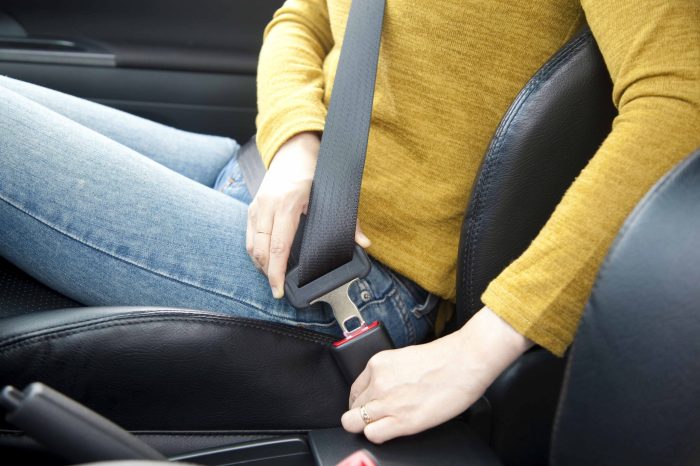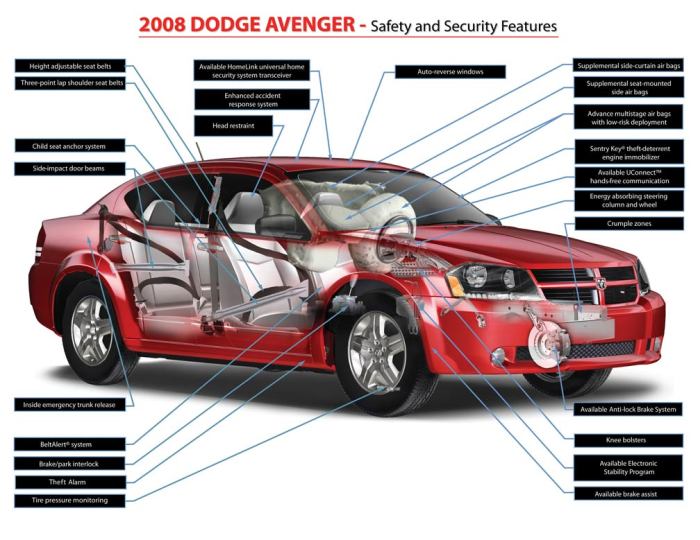Car safety features are the real deal when it comes to keeping drivers and passengers safe on the road. From advanced technologies to impact on insurance, buckle up for a ride through the world of automotive safety.
We’ll dive into the types of safety features, their evolution, and how they affect insurance rates, giving you a comprehensive view of why these features are more than just bells and whistles.
Importance of Car Safety Features

Car safety features are crucial for drivers and passengers alike as they play a significant role in ensuring the well-being and protection of individuals on the road.
These safety features are designed to reduce the likelihood of accidents and minimize the impact of collisions, ultimately saving lives and preventing serious injuries.
Effectiveness of Safety Features
- Safety features such as airbags, seat belts, and anti-lock braking systems have been proven to significantly reduce the risk of fatalities and injuries in car accidents.
- According to the National Highway Traffic Safety Administration (NHTSA), seat belts alone saved an estimated 14,955 lives in 2017.
- Studies have shown that vehicles equipped with electronic stability control (ESC) have a 50% lower risk of a fatal single-vehicle crash compared to those without ESC.
Types of Advanced Safety Features

Car manufacturers have been incorporating advanced safety features in modern vehicles to enhance driver and passenger safety. These features utilize cutting-edge technology to prevent accidents and reduce the severity of collisions. Let’s explore some common advanced safety features found in cars today.
Adaptive Cruise Control
Adaptive cruise control is a system that automatically adjusts the vehicle’s speed to maintain a safe following distance from the car ahead. It uses sensors to detect the distance and speed of the vehicle in front, allowing the car to accelerate or decelerate accordingly. This feature helps reduce driver fatigue and the likelihood of rear-end collisions.
Lane Departure Warning, Car safety features
Lane departure warning systems alert drivers when they unintentionally drift out of their lane without using a turn signal. The system uses cameras or sensors to monitor lane markings and provides visual or auditory warnings to bring the driver’s attention back to the road. This feature is especially useful in preventing accidents caused by distracted driving or drowsiness.
Automatic Emergency Braking
Automatic emergency braking (AEB) is a feature that detects potential collisions with vehicles or pedestrians and automatically applies the brakes if the driver fails to respond in time. This advanced safety feature helps mitigate or avoid accidents by reducing the impact speed or bringing the vehicle to a complete stop, thus preventing or minimizing injuries and damage.
These advanced safety features work together seamlessly to create a comprehensive safety system in cars. Adaptive cruise control helps maintain a safe distance from other vehicles on the road, while lane departure warning alerts drivers to stay within their lane. In case of an imminent collision, automatic emergency braking can intervene to prevent or reduce the severity of accidents. By combining these technologies, modern vehicles provide an extra layer of protection for drivers and passengers on the road.
Impact of Safety Features on Insurance
When it comes to car insurance, having advanced safety features can actually impact your premiums in a positive way. Insurance companies take into account the safety features present in a vehicle when determining insurance rates. The presence of these features can lead to lower premiums as they reduce the risk of accidents and injuries, ultimately saving the insurance company money.
Insurance Evaluation of Safety Features
Insurance companies evaluate the presence of safety features by looking at the specific technologies installed in a vehicle. Features such as automatic emergency braking, lane departure warning, adaptive cruise control, and blind-spot monitoring are highly valued by insurance companies. These technologies help prevent accidents or minimize their severity, which reduces the likelihood of filing a claim.
- Insurance companies may offer discounts for vehicles equipped with safety features like:
- Anti-lock brakes (ABS)
- Electronic stability control (ESC)
- Advanced airbag systems
- Daytime running lights
Installing safety features can lead to discounts of up to 20% on insurance policies, as they demonstrate a commitment to safety and reduce the risk of accidents.
Evolution of Car Safety Features
Car safety features have come a long way since the invention of the automobile. From basic seat belts to advanced technologies, the evolution of safety features has been driven by advancements in technology and a growing emphasis on passenger safety.
Development of Safety Features
- Seat Belts: One of the earliest safety features introduced in cars, seat belts were designed to prevent occupants from being ejected during a collision.
- Airbags: In the 1980s, airbags became a standard feature in most vehicles, offering an additional layer of protection in the event of a crash.
- Antilock Braking System (ABS): ABS helps prevent the wheels from locking up during hard braking, allowing the driver to maintain control of the vehicle.
Advancements in Technology
- Collision Warning Systems: Using sensors and cameras, these systems alert drivers to potential collisions and can even apply the brakes automatically to prevent accidents.
- Lane Departure Warning: Alerts drivers when they unintentionally drift out of their lane, reducing the risk of side collisions.
- Adaptive Cruise Control: Automatically adjusts the vehicle’s speed to maintain a safe following distance from the car ahead, helping to prevent rear-end collisions.
Future Trends and Innovations
- Autonomous Vehicles: The development of self-driving cars promises to revolutionize road safety by eliminating human error, the leading cause of accidents.
- Biometric Sensors: Future cars may feature biometric sensors that can detect driver fatigue or impairment, reducing the risk of accidents caused by drowsy driving.
- Vehicle-to-Everything (V2X) Communication: This technology allows vehicles to communicate with each other and with infrastructure, enabling real-time data sharing to prevent accidents and improve traffic flow.